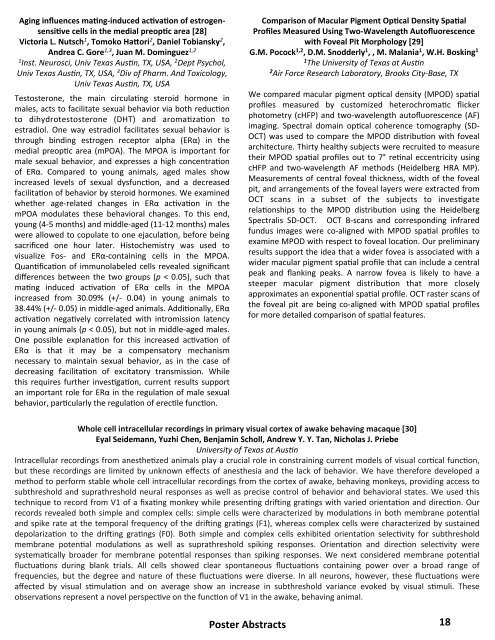Program - The Institute for Neuroscience - The University of Texas at ...
Program - The Institute for Neuroscience - The University of Texas at ...
Program - The Institute for Neuroscience - The University of Texas at ...
Create successful ePaper yourself
Turn your PDF publications into a flip-book with our unique Google optimized e-Paper software.
Aging influences maYng-‐induced acYvaYon <strong>of</strong> estrogen-‐<br />
sensiYve cells in the medial preopYc area [28]<br />
Victoria L. Nutsch 1 , Tomoko Hacori 2 , Daniel Tobiansky 2 ,<br />
Andrea C. Gore 1,3 , Juan M. Dominguez 1,2<br />
1 Inst. Neurosci, Univ <strong>Texas</strong> Aus5n, TX, USA, 2 Dept Psychol,<br />
Univ <strong>Texas</strong> Aus5n, TX, USA, 3 Div <strong>of</strong> Pharm. And Toxicology,<br />
Univ <strong>Texas</strong> Aus5n, TX, USA<br />
Testosterone, the main circula8ng steroid hormone in<br />
males, acts to facilit<strong>at</strong>e sexual behavior via both reduc8on<br />
to dihydrotestosterone (DHT) and aroma8za8on to<br />
estradiol. One way estradiol facilit<strong>at</strong>es sexual behavior is<br />
through binding estrogen receptor alpha (ERα) in the<br />
medial preop8c area (mPOA). <strong>The</strong> MPOA is important <strong>for</strong><br />
male sexual behavior, and expresses a high concentra8on<br />
<strong>of</strong> ERα. Compared to young animals, aged males show<br />
increased levels <strong>of</strong> sexual dysfunc8on, and a decreased<br />
facilita8on <strong>of</strong> behavior by steroid hormones. We examined<br />
whether age-‐rel<strong>at</strong>ed changes in ERα ac8va8on in the<br />
mPOA modul<strong>at</strong>es these behavioral changes. To this end,<br />
young (4-‐5 months) and middle-‐aged (11-‐12 months) males<br />
were allowed to copul<strong>at</strong>e to one ejacula8on, be<strong>for</strong>e being<br />
sacrificed one hour l<strong>at</strong>er. Histochemistry was used to<br />
visualize Fos-‐ and ERα-‐containing cells in the MPOA.<br />
Quan8fica8on <strong>of</strong> immunolabeled cells revealed significant<br />
differences between the two groups (p < 0.05), such th<strong>at</strong><br />
ma8ng induced ac8va8on <strong>of</strong> ERα cells in the MPOA<br />
increased from 30.09% (+/-‐ 0.04) in young animals to<br />
38.44% (+/-‐ 0.05) in middle-‐aged animals. Addi8onally, ERα<br />
ac8va8on nega8vely correl<strong>at</strong>ed with intromission l<strong>at</strong>ency<br />
in young animals (p < 0.05), but not in middle-‐aged males.<br />
One possible explana8on <strong>for</strong> this increased ac8va8on <strong>of</strong><br />
ERα is th<strong>at</strong> it may be a compens<strong>at</strong>ory mechanism<br />
necessary to maintain sexual behavior, as in the case <strong>of</strong><br />
decreasing facilita8on <strong>of</strong> excit<strong>at</strong>ory transmission. While<br />
this requires further inves8ga8on, current results support<br />
an important role <strong>for</strong> ERα in the regula8on <strong>of</strong> male sexual<br />
behavior, par8cularly the regula8on <strong>of</strong> erec8le func8on.<br />
Comparison <strong>of</strong> Macular Pigment OpYcal Density SpaYal<br />
Pr<strong>of</strong>iles Measured Using Two-‐Wavelength Aut<strong>of</strong>luorescence<br />
with Foveal Pit Morphology [29]<br />
G.M. Pocock 1,2 , D.M. Snodderly 1 , , M. Malania 1 , W.H. Bosking 1<br />
1 <strong>The</strong> <strong>University</strong> <strong>of</strong> <strong>Texas</strong> <strong>at</strong> Aus5n<br />
2 Air Force Research Labor<strong>at</strong>ory, Brooks City-‐Base, TX<br />
We compared macular pigment op8cal density (MPOD) spa8al<br />
pr<strong>of</strong>iles measured by customized heterochroma8c flicker<br />
photometry (cHFP) and two-‐wavelength aut<strong>of</strong>luorescence (AF)<br />
imaging. Spectral domain op8cal coherence tomography (SD-‐<br />
OCT) was used to compare the MPOD distribu8on with foveal<br />
architecture. Thirty healthy subjects were recruited to measure<br />
their MPOD spa8al pr<strong>of</strong>iles out to 7° re8nal eccentricity using<br />
cHFP and two-‐wavelength AF methods (Heidelberg HRA MP).<br />
Measurements <strong>of</strong> central foveal thickness, width <strong>of</strong> the foveal<br />
pit, and arrangements <strong>of</strong> the foveal layers were extracted from<br />
OCT scans in a subset <strong>of</strong> the subjects to inves8g<strong>at</strong>e<br />
rela8onships to the MPOD distribu8on using the Heidelberg<br />
Spectralis SD-‐OCT. OCT B-‐scans and corresponding infrared<br />
fundus images were co-‐aligned with MPOD spa8al pr<strong>of</strong>iles to<br />
examine MPOD with respect to foveal loca8on. Our preliminary<br />
results support the idea th<strong>at</strong> a wider fovea is associ<strong>at</strong>ed with a<br />
wider macular pigment spa8al pr<strong>of</strong>ile th<strong>at</strong> can include a central<br />
peak and flanking peaks. A narrow fovea is likely to have a<br />
steeper macular pigment distribu8on th<strong>at</strong> more closely<br />
approxim<strong>at</strong>es an exponen8al spa8al pr<strong>of</strong>ile. OCT raster scans <strong>of</strong><br />
the foveal pit are being co-‐aligned with MPOD spa8al pr<strong>of</strong>iles<br />
<strong>for</strong> more detailed comparison <strong>of</strong> spa8al fe<strong>at</strong>ures.<br />
Whole cell intracellular recordings in primary visual cortex <strong>of</strong> awake behaving macaque [30]<br />
Eyal Seidemann, Yuzhi Chen, Benjamin Scholl, Andrew Y. Y. Tan, Nicholas J. Priebe<br />
<strong>University</strong> <strong>of</strong> <strong>Texas</strong> <strong>at</strong> Aus5n<br />
Intracellular recordings from anesthe8zed animals play a crucial role in constraining current models <strong>of</strong> visual cor8cal func8on,<br />
but these recordings are limited by unknown effects <strong>of</strong> anesthesia and the lack <strong>of</strong> behavior. We have there<strong>for</strong>e developed a<br />
method to per<strong>for</strong>m stable whole cell intracellular recordings from the cortex <strong>of</strong> awake, behaving monkeys, providing access to<br />
subthreshold and supr<strong>at</strong>hreshold neural responses as well as precise control <strong>of</strong> behavior and behavioral st<strong>at</strong>es. We used this<br />
technique to record from V1 <strong>of</strong> a fixa8ng monkey while presen8ng driBing gra8ngs with varied orienta8on and direc8on. Our<br />
records revealed both simple and complex cells: simple cells were characterized by modula8ons in both membrane poten8al<br />
and spike r<strong>at</strong>e <strong>at</strong> the temporal frequency <strong>of</strong> the driBing gra8ngs (F1), whereas complex cells were characterized by sustained<br />
depolariza8on to the driBing gra8ngs (F0). Both simple and complex cells exhibited orienta8on selec8vity <strong>for</strong> subthreshold<br />
membrane poten8al modula8ons as well as supr<strong>at</strong>hreshold spiking responses. Orienta8on and direc8on selec8vity were<br />
systema8cally broader <strong>for</strong> membrane poten8al responses than spiking responses. We next considered membrane poten8al<br />
fluctua8ons during blank trials. All cells showed clear spontaneous fluctua8ons containing power over a broad range <strong>of</strong><br />
frequencies, but the degree and n<strong>at</strong>ure <strong>of</strong> these fluctua8ons were diverse. In all neurons, however, these fluctua8ons were<br />
affected by visual s8mula8on and on average show an increase in subthreshold variance evoked by visual s8muli. <strong>The</strong>se<br />
observa8ons represent a novel perspec8ve on the func8on <strong>of</strong> V1 in the awake, behaving animal.<br />
Poster Abstracts<br />
18


